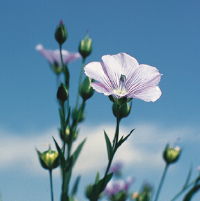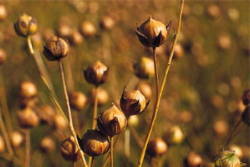|
|
Common flax was one of the first crops
domesticated by man. Flax is thought to have originated in the Mediterranean
region of Europe; the Swiss Lake Dweller People of the Stone Age apparently
produced flax utilizing the fiber as well as the seed. Linen cloth made from
flax was used to wrap the mummies in the early Egyptian tombs. In the United
States, the early colonists grew small fields of flax for home use, and
commercial production of fiber flax began in 1753. However, with the invention
of the cotton gin in 1793, flax production began to decline. Presently the
major fiber flax producing countries are the Soviet Union, Poland, and France.

France is the world’s major flax producer, growing 64,000 tons
annually on 55,500 hectares of land. It is ranked number-one for
quality. Second for quality is Belgium, coming in with 15,300 tons of
flax grown on 13,300 hectares. Holland is third with 4,600 tons grown on
4,000 hectares. By contrast, China — ranked sixth for quality —
grows flax on 100,000 hectares, but produces only 31,000 tons of fiber.
Properties
70% is composed of cellulose, it cannot provoke allergies, absorbs humidity and allows the skin to breathe: therefore it is very indicated in the manufacture of summer articles. Very resistant, above all if wetted it can be washed many times without alteration, rather it becomes softer, something very important for articles of clothing and for daily use which require frequent washing such as shirts. Having very low elasticity, linen cloths do not deform themselves.
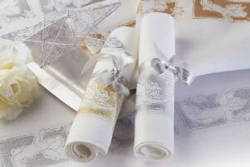
European
linen fabrics today are luxurious, elegant, comfortable and practical.
Linen is thermo regulating, non-allergenic, antistatic and antibacterial.
Because it can absorb up to 20 times its weight in moisture before it
feels damp, linen feels cool and dry to the touch. It is not by accident
that the world’s oldest and most useful fiber is still in great
demand.
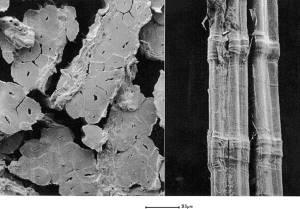
Applications
- Table wear
- Suiting
- Clothing apparel
- Surgical thread
- Sewing thread
- Decorative
fabrics
- Bed linen
- Kitchen towels
- High quality
papers
- Handkerchief
linen
- Shirting
- Upholstery
- Draperies
- Wall
coverings
- Artist’s
canvases
- Luggage fabrics
- Paneling
- Insulation
- Filtration
- Fabrics for light aviation
use
- Automotive end uses
- Reinforce plastics and composite materials.
- Flax could
conceivably be mixed with excess grass seed straw or softwood fiber in composite
boards
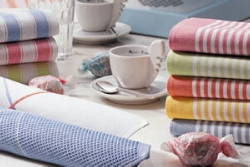
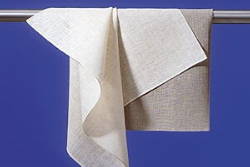
Consumers around the world buy linen because they
like the way it looks, feels and performs. With new varieties of flax;
new processing techniques; and new ways of spinning, weaving and
finishing, the European linen industry has reinvented itself. And all of
the links in the supply chain are working together through the European
flax and linen organization, Masters of Linen, Paris, to market linen
globally to a new and growing trade of niche players.
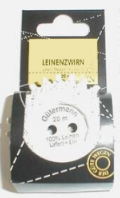
The flax plant has also a
couple of other important end uses
- Industrial Uses:
Flax is still produced for its oil rich seed. Linseed
oil has been used as a drying agent for paints, varnishes, lacquer, and printing
ink. Unfortunately these markets have eroded somewhat over the years with the
production of synthetic resins and latex. One bright spot in the market has been
the use of linseed oil as an anti-spalling treatment for concrete where freezing
and thawing effects have created problems on streets and sidewalks. Occasionally
the straw is harvested and used to produce some paper products.
- Livestock Feed:
Linseed oil meal is an excellent protein source for livestock containing
about 35% crude protein. Flax straw on the other hand, makes a very poor quality
forage because of its high cellulose and lignin content.
- Human Food:
Recently there has been some interest in seed flax as a health food because
of its high amount of polyunsaturated fatty acids in the oil

How to treat articles in linen
White articles should be washed in the washing machine at 60° C, whilst colored ones at a lesser temperature. White articles should be ironed damp with a very hot iron, even steam, first on the inside, then on the right side.
Colored articles, above all if dark, should be ironed only on the inside. Starching is not needed as with ironing linen returns to being stiff. If you hang the articles folded in a suitcase over a bath of hot water, they will return to their original state: the steam will help to soften the folds.
Linen clothing wrinkles easily - therefore the trade speaks
about "Edelknitter" = noble wrinkle
|
| Grades
|
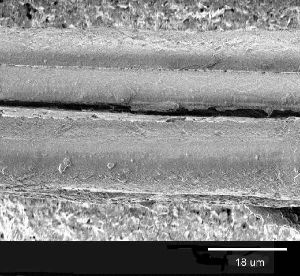 |
| Processability
Flax plants are
pulled from the ground rather than cut, in order to obtain the full length of
the fibers, and to prevent fiber discoloration. At one time, this work was done
all by hand. Today pulling machines are used. The equipment is often owned by cooperatives and loaned
to each farmer.
The
plants are first de-seeded. Next comes retting — separating the straw
or bark from the fiber. There are two main methods of retting — dew
and water. Dew retting, the process mostly used in Western Europe, is done by spreading the flax in the field. The actions
of dew, rain and sun, along with soil-borne bacteria, help to loosen and
dissolve the outer bark. After retting, the farmers roll and store the flax
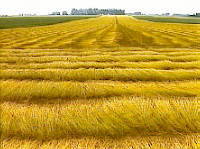
Flax also can be water-retted. This process involves submerging the flax
in water for between six and 20 days, allowing bacterial action to cause
the bark to be loosened. Today, many farmers consider this process too
expensive. Egypt is one country where flax is water-retted — in the
Nile River.
Scutching is the next
step to be done. This process
extracts the flax fibers from the retted straw. Special machines
move the flax on long tables to remove impurities. Other equipment is used to further thresh the flax and extract the
fibers. During the scutching process the flax is divided into fine fibers called line, shorter fibers
are called tow and shives.
Shives are the woody part of the plant.
Line is further processed by hackling to form sliver. Line sliver is
weighed, manually sorted and packed in bales or rollers weighing 100
kilograms. Line can be wet- or dry-spun.
Tow can be dry-spun on the cotton system or spun on the worsted system.
It is also used for non-wovens, including paper, and for technical
products such as insulation. Shives are packed and shipped for a variety
of industrial products.
The linen fibres are mixed with cotton, wool, silk, viscose, and polyester and this mixed thread allows one to obtain many types of cloth. The combination of two fibres allows one to obtain a different "hand", i.e. a consistency and aspect different from those obtained with simple threads.
Handmade textiles deriving from the production zones of France, Belgium,
Germany, Austria and Holland are the best - they claim the quality mark MASTERS OF LINEN. Linen is also cultivated in Eastern Europe, Russia, Brazil, China and the Baltic countries, but its quality is not comparable to that of Western Europe.
Flax
spinning technology
|
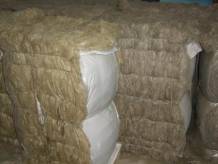
Import flax
material
|
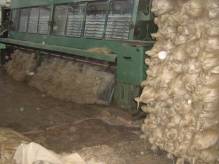
Hackling
machine process
|
|
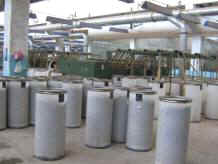
Spreader
process
- Drawing
|
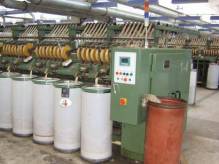
Sliver
process
|
|
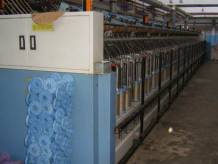
Fly
frame process
|
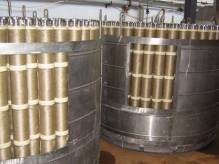
Boiling-out
process
|
|
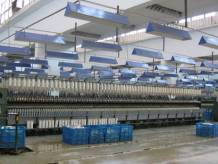
Spinning
frame process
|
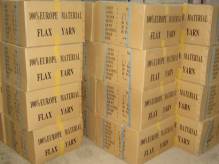
Finished Carton packing
|
|
| Background
information
History of flax
| About 3,000 B.C. |
Flax is cultivated in Babylon.
Burial chambers depict flax cultivation and clothing from flax
fibres.
|
| About 650 B.C. |
Hippocrates writes about using flax for the relief of
abdominal pains.
In the same era, Theophrastus recommends the use of flax mucilage
as a cough remedy.
|
| About 1st Century A.D. |
Tacitus praises the virtues of flax. |
| About 8th Century A.D. |
Charlemagne considered flax so important
for the health of his subjects that he passed laws and regulations
requiring its consumption. |
| About 15th Century A.D. |
Hildegard von Bingen used flax meal in hot compresses
for the treatment of both external and internal ailments |

Winter
Flax
Recently in
France a new variety of winter flax was developed. It can be
sown in September and harvested in June. The
advantages of winter flax are many. Retting conditions are better in
June than in July, when spring crops are ready. Generally, growing
fields are idle in winter, so flax cultivation helps to prevent soil
erosion. Also, being able to pull flax a month earlier extends the use of
the pulling machines.
This new
winter flax called Adélie can grow in temperatures as cold as -10°C, so it can be planted
in Germany and Eastern Europe, where winters are harsh. It is expected
to be available commercially in about two years.
|
| Our
supplier partner
|
|
|



